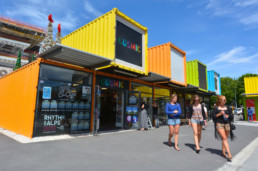How to Rent a Pop-Up Store?
What is a Pop-Up Store?
A pop-up store is a temporary store that typically offers customers and visitors a unique experience, something out of the ordinary. It provides small, medium, or large companies a way to access a market quickly and test new product concepts. A pop-up store is also used for branding purposes. Therefore, if you need to get the word out, a temporary store can be a very cost-effective way to build brand awareness in local communities and major cities by demonstrating your company’s creativity and ingenuity.
A pop-up store often uses freight containers or unused retail space sitting idle because short-term arrangements can be made.
Why Rent Pop-Up Stores and Store Materials?
Space and materials needed for a pop-up store is only used temporarily. Therefore, it makes more sense to rent the space and the materials needed to create an environment and store experience that will wow visitors. Pop-up stores have temporary needs for materials, display cases, games, and other creative ideas and access to goods that a permanent retail store and temporary retail store needs. Rent Items fully supports unique spaces such as pop-up shops because it is an efficient and cost-effective way to reach others with good product ideas.
How to Setup a Pop-up Store?
If you have a new product or would like to generate more brand awareness in a specific location, a pop-up store is a great idea. The following are some high-level steps to take in order to get your pop-up store established.
Step 1: Research what has worked and not worked for others.
Conduct empirical research by doing online searches and learning about the evolution and trends of pop-up shops and stores. Read: InkBot Design’s Article
Step 2: Talk to those that create pop-up stores as their primary occupation.
Capture all the pros and cons, things that work and don’t work among the professionals. This is a very important step, so don’t skip it because you are afraid to talk to people. Consider: The Pop Up Shop Agency
Step 4: Have clear objectives, quantifiable goals, and a project execution checklist.
Make sure you know why you’re creating a temporary store, what the quantifiable goals are such as # of visitors, total sales each day, etc. Also, make sure you have a checklist of all the things you need for the store in order to design it, built it, and operate it. Visit: DPM & SmartSheets for ideas and project templates.
Step 5: Know your target audience and their persona.
You are not looking for just warm bodies to come to your store. You are looking to attract specific people with specific interests, demographics, and geographic characteristics. Make sure you create a persona of what visitors should be interested in your pop-up store. See Invision App Article & JustInMind Template
Step 6: Brainstorm and develop 1-3 solid themes/concepts for your pop-up store. Choose one.
Make sure your theme, concept, and creative ideas make sense and are clear to your target audience. A little mystery is ok, but too much mystery can create significant unclarity. Be able to confidently and comfortably answer, Does this pop-up store concept appeal to your target audience? If you don’t know the answer, ask people that are in your target audience.
Step 7: Be highly critical of the location you choose.
The location of your pop-up store can significantly alter your attractiveness and ROI. Typically, you want a location that is easy to get to, does not cost an arm and leg to get, allows you to alter the space in a way that allows you to be highly creative in order to create your Wow Factor. Visit: ARetailSpace
Step 8: Create Buzz -Let people know about your pop-up store.
For example, contact local media sources that cover your industry, new products, or retail activity. Also, contact local influencers and invite them as VIP members to visit the store and receive special benefits. Visit: PRNewswire
Temporary Store Requirements
- Needs to have a wow factor such as a big attractive giveaway.
- People need to know that the store is only open for a limited amount of time and urgency is critical.
- The location of the store is critical. Typically, high traffic areas are the best, but it depends on your target audience and product offering.
- Make sure you have established proper insurance for this temporary space.
Remember, rent what you need on the Rent Items’ Marketplace instead of buying things that will only go to waste.
RentItems is a peer-to-peer rental marketplace. We help individuals and local business owners share assets they own by renting it to those in their local community or traveling to their city. Take items sitting unused in your garage, basement, self-storage unit, retail store, or warehouse and put it to better use. Become more sustainable by joining the sharing economy today and register at Rentitems.com.

